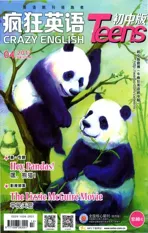熊猫宝宝带来的曙光
2017-05-04byDavidGeorgeGordon
by David George Gordon
翻译:法比仔
熊猫宝宝带来的曙光
Giant Panda Cubs Give Hope to an Endangered Species
by David George Gordon
翻译:法比仔

当下,人类一直在努力地保护我们可爱的熊猫。而熊猫宝宝的相继诞生,也为原本濒危的熊猫物种带来了新的曙光。
Pandas at Risk
Scientists1)estimatethat fewer than 2,000 giant pandas live in the mountains ofcentral China.About another 200 giant pandas live in zoos, mostly in China.Giant pandas are among the rarest of the world’s2)living3)mammals.
Raising Babies
“Every4)newbornpanda is important,” says the leader of the giant panda research team at the San Diego Zoo.“After they have grown to5)adulthood, some of the bears could be released into the6)mountainouswilds,” he says.And those that7)mateandgive birth tomore cubs will help rebuild China’s small population of wild pandas.
“Breeding giant pandas is no easy thing,” says the leader.Female giant pandas can produce cubs only once every two years.In the wild, an adult female may successfully raise fve to eight cubs in her lifetime.

词组加油站
central China华中地区
give birth to生产,生育
conservation group保护组织
Giant pandas once wandered across China to its eastern coast.But as more people made their homes and began to farm the land, the pandas lost a lot of their habitat and most of their food.
Hope for the Future
Today, theconservation groups, scientists, zoo workers and the Chinese government work together to protect the pandas’ habitat.Many think about creating bamboo8)corridors—one hope for saving the giant panda from extinction.These corridors would create one larger habitat for all wild pandas.

濒危的熊猫们
据科学家们统计,生活在华中地区深山里头的大熊猫不超过2000只,另外约有200只大熊猫生活在动物园里,且主要分布在中国。大熊猫是世界上现存的最为珍稀的哺乳类动物之一。
饲养熊猫宝宝
“我们重视每一只新生的熊猫宝宝,”美国圣地亚哥动物园大熊猫研究团队的领队说。“在这些熊猫宝宝长大以后,其中的一些会回归山林野外生活,”他说道。另外,一些熊猫会继续交配,生育出更多的熊猫宝宝,这将有助于中国野生大熊猫种群的数量回升。
“繁殖大熊猫绝非易事,”领队说。雌性大熊猫每两年才繁衍一次。若是在野外,一只成年的雌性熊猫在其一生中大概能成功养育五到八只熊猫宝宝。
大熊猫的足迹曾经一路穿越中国,直至东部的沿海地区。可是,由于越来越多的人开始扎根定居、开荒耕地,熊猫失去了它们的许多栖息地和大部分食物。
对未来的憧憬
如今,相关的保护组织、科学家、动物园里的员工,以及中国政府,正致力于保护大熊猫的栖息地。许多人考虑建造竹林地带,以保护大熊猫免于灭绝。这些地带能为所有的野生熊猫提供一片更大的栖息场所。
1 ) estimate [΄estɪmeɪt] v.估计,判断
2 ) living [΄lɪvɪŋ] adj.活着的,现存的
3 ) mammal [΄mæml] n.哺乳动物
4 ) newborn [njuː΄bɔːn] adj.新生的,初生的
5 ) adulthood [΄ædʌlthʊd] n.成年
6 ) mountainous [΄maʊntɪnəs] adj.多山的
7 ) mate [meɪt] v.交配
8 ) corridor [΄kɒrɪdɔː] n.走廊地带
